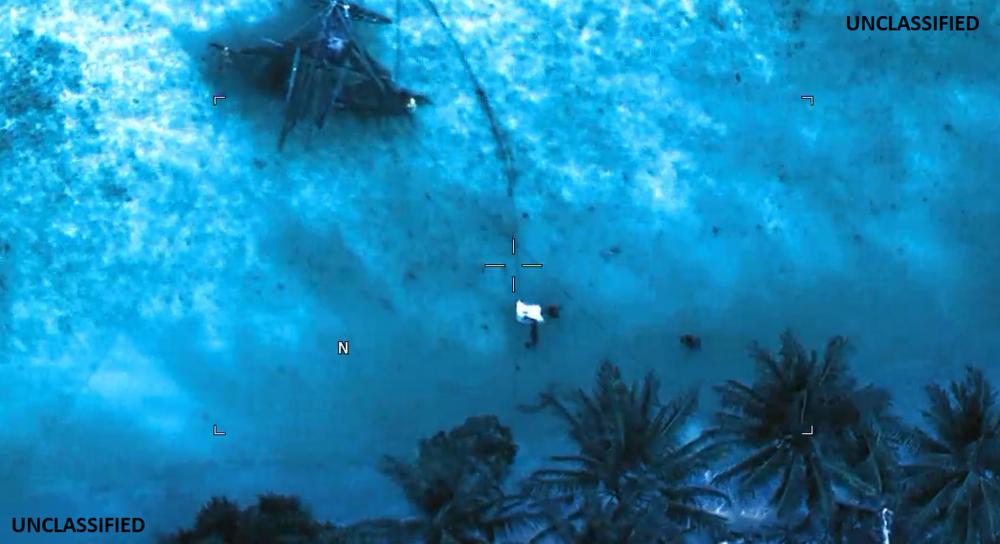Imagery Available: U.S. Coast Guard, U.S. Air Force, good Samaritans respond to 406 beacon in Federated States of Micronesia
U.S. Coast Guard sent this bulletin at 02/28/2023 09:50 PM EST
| News Release |
U.S. Coast Guard Forces Micronesia / Sector Guam |
U.S. Coast Guard, U.S. Air Force, good Samaritans respond to 406 beacon in Federated States of Micronesia
Editor's Note: Click on the images above to view more or download high-resolution versions.
SANTA RITA, Guam — The U.S. Coast Guard, U.S. Air Force, and good Samaritans responded to a 406-beacon alert in the Federated States of Micronesia on Friday, Feb. 17, 2023.
A U.S. Air Force 119th Wing MQ-9 Reaper, an unmanned aircraft, and good Samaritans aboard the motor vessel Kyowa Falcon investigated the position of the alert about a mile south of West Fayu Island in western FSM 290 nautical miles (334 statute miles) west of Chuuk. They located a group of fishermen aboard two traditional canoes who had tested their locator beacon but were found not in distress.
“This case illustrates the value of a personal locator beacon and how quickly responders can come together to search despite vast distances and remote nature of many locations in Oceania,” said Lt. Kira Adams, the command center chief at the U.S. Coast Guard Forces Micronesia Sector Guam Joint Rescue Sub-center. “We appreciate the quick response and support from our DoD partners in this case and the mariners aboard the Kyowa Falcon who volunteered their time and willingly diverted from their course to assist.”
Watchstanders at the FM/SG JRSC received notification of a 406 personal locator beacon alert Friday afternoon. The registered owner is a man who lends these beacons to fishermen. He reportedly lent this beacon to a group of fishermen who departed Satawal, in FSM, about a week ago to go fishing.
The lender advised watchstanders the group of 15 adult men is aboard two traditional non-motorized canoes equipped with citizen band radios using high-frequency radio communication, a week’s worth of provisions, and the personal locator beacon. They do not have any life jackets or life rafts. The group is due back to Satawal in about a week. Their last daily check-in over HF with their shoreside point of contact was 5 a.m. Friday morning, and they reported no issues.
Without regular organic U.S. Coast Guard assets in this region, the team requested assistance from the U.S. Air Force through U.S. Indo-Pacific Command to fly their unmanned aircraft and the help of good Samaritans aboard the vessel Kyowa Falcon. This roll-on roll-off car and cargo carrier participates in the AMVER program and was transiting the area. The USCGC Oliver Henry (WPC 1140), operating in the Commonwealth of the Northern Marianas on a regular patrol, was also diverted.
The unmanned aircraft operators initially sighted one of the two canoes. The Kyowa Falcon arrived off West Fayu Island, and the master dispatched the ship’s rescue boat to the island. The crew reported contact with the fishermen on the island; all 15 men were there and safe. They were in possession of the PLB they activated. The canoe sighted by the U.S. Air Force crew was damaged. The men reported help was coming from Satawal, and they did not need further assistance.
“We manage an enormous area of responsibility, and our closest U.S. Coast Guard asset was 30 hours away. The efforts of the U.S. Air Force and the Kyowa Falcon crews brought this case to a close much faster, ensuring more rapid assistance for these mariners had they been in distress and allowing the Oliver Henry crew on their current patrol ready to respond should the need arise,” said Adams.
The forecasted weather on scene included winds from the southeast at 12 knots (14 mph) with seas from the east at 5 feet, expected to deteriorate overnight, becoming winds at 16 knots (18 mph) with seas to 7 feet Saturday.
The U.S. Coast Guard recommends using personal locator beacons and emergency position-indicating beacons. This tool helps responders by pinpointing a user's location, vastly reducing search areas and allowing responders to find anyone in distress more quickly and efficiently. Beacons should be properly registered to be more effective and provide a point of contact from whom search and rescue coordinators can get more details. Additionally, leaving word about voyage schedules and taking adequate supplies, including lifejackets and communications devices, all vastly increase survival chances and the possibility of being located in an emergency.
The Kyowa Falcon is a 143-meter (469-foot) Marshall Islands-flagged commercial vessel on a voyage from Palau to Chuuk. They participate in the Automated Mutual-Assistance Vessel Rescue program, a worldwide voluntary reporting system sponsored by the U.S. Coast Guard. It is a computer-based global ship-reporting system used by search and rescue authorities to arrange for assistance to persons in distress at sea.
The U.S. Department of Defense aircraft crews are currently in Guam participating in the U.S. Pacific Air Forces’ Cope North 2023; a multilateral U.S. Pacific Air Forces-sponsored field training exercise focused on trilateral airborne integration for large-force employment, agile combat employment, and humanitarian assistance and disaster relief training. The exercise ran from Feb. 8 to 24.
FM/SG comprises nearly 300 personnel conducting response and prevention departments with administrative and logistics support to the Joint Rescue Sub-Center, three fast response cutters, a small boat station, and a marine safety detachment in Saipan. The unit provides a significant portion of the U.S. Coast Guard’s enduring regional presence serving the people of the Pacific by conducting 10 of the Service’s 11 statutory missions with a focus on search and rescue, defense readiness, living marine resources protection, and ensuring commerce through marine safety and ports, waterways, and coastal security.
For more U.S. Coast Guard Forces Micronesia/Sector Guam news, visit us on DVIDS or subscribe! You can also visit us on Facebook or Instagram at @USCGForcesMicronesia or Twitter @USCGFMSG.
-USCG-




